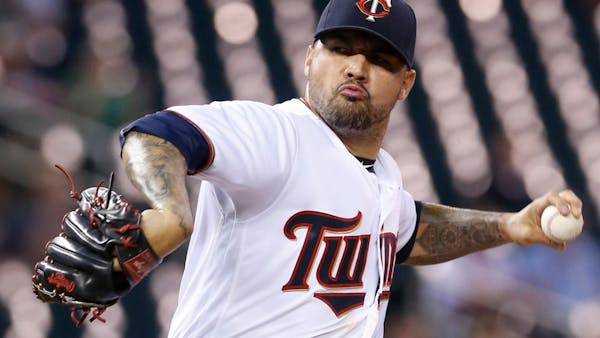Orioles slugger Chris Davis has done plenty of damage to the Twins over the years, as 27 RBI in 36 games attests. But he may have done them a big favor, too.
It was Davis who explained to Kennys Vargas the mindset necessary to hit a lot of home runs. "I wasn't thinking about 'how to hit a homer' when I went up there, but Chris Davis told me I should," Vargas said Tuesday. "I'm hitting in the four or five spot [in the batting order]. I need to hit home runs."
And to do that, Vargas said, he made a mechanical adjustment that he hopes has changed the course of his career: He added a slight uppercut — well, slight at point of impact. When the ball lands some 425 feet away and clangs off a billboard far beyond the fence, as one did Sunday at Citi Field in New York, it doesn't seem slight at all.
"That's what I want. I want to hit it off the fence, or in the gap, or over the fence, every time," Vargas said. "You have to elevate the ball."
That's as opposed to hitting a series of ground balls, as Vargas did last season — easily converted into groundouts and double plays for someone as large as the 6-foot-5, 290-pound Puerto Rican slugger. While Vargas still strikes out in nearly 30 percent of his at-bats, he's managed to make a sizable alteration in what happens when he gets the bat on the ball.
Last year, 51.2 percent of all balls he put in play were hit on the ground, according to fangraphs.com, and he was 11-for-62 (.177) when that happened. Only 23.1 percent were fly balls, and five cleared the fence. This season, that proportion is flipped: Vargas' ground balls are down to just 35.1 percent of his balls in play, while 45.9 percent are fly balls, and eight were home runs.
Perhaps most important: He's hitting the ball harder. Fangraphs.com classifies 42.1 percent of balls he puts in play as hard-hit, compared to 28.1 percent last year.
"I can tell there's more hard contact," Vargas said. "Last year, I was hitting on top of the ball all the time, but I decided to change all that."
By beginning his swing a split-second earlier, and starting that swing by quickly dropping his hands, Vargas is creating a slight incline on his swing.
If he makes contact, he said, his strength should do the rest.
"I tried to do it in winter ball in Puerto Rico, and I hit [about] .320 and was MVP," Vargas said with a smile. "I said, OK, if I can hit it like that, it's a good idea."
The results are positive — Vargas has a .973 OPS and his slugging percentage stands at a career-high .580. For a player whose natural positions — first base and designated hitter — appear blocked by a handful of current Twins, those numbers give Vargas a chance to keep his roster spot next year.
His manager, however, sounds a little skeptical about Vargas' uppercut swing, pointing out that it can also lead to pop-ups if the upward plane gets too steep.
"I'm sure he'd like to be more consistent in terms of elevating the ball and getting it over the fence, but it can be a double-edged sword," Molitor said.
"You [can] start to develop an undercut and have trouble catching the higher velocity and you pop up more than you hit home runs. There's a lot of times when a line drive works better than elevating the ball."
For now, though, Vargas intends to discover whether his readjusted swing carries him as far as some of the tape-measure blasts he's hit this month.
"I'm a [cleanup] hitter," he said. "I have to hit home runs."
Bills and Chargers get their receivers in Day 2 of the NFL draft in Keon Coleman and Ladd McConkey
Rory McIlroy and Shane Lowry remain tied for lead lead in the Zurich Classic of New Orleans

Turner 'a game-wrecker' for Vikings pass rush

